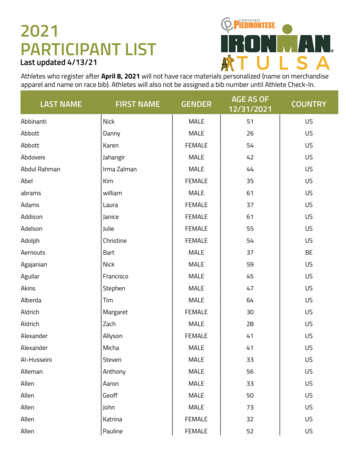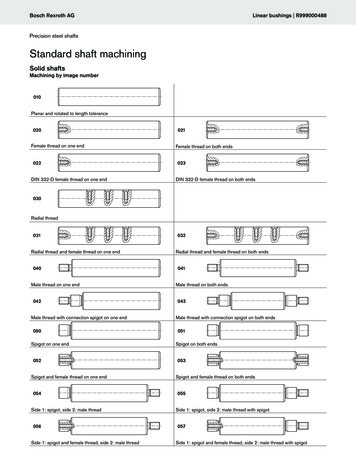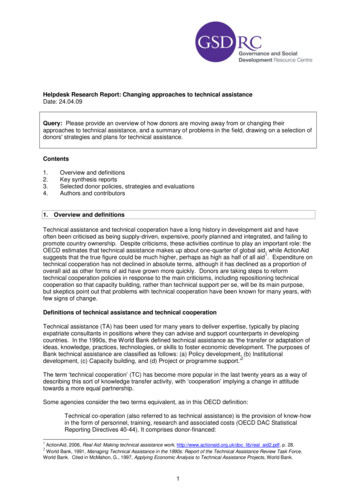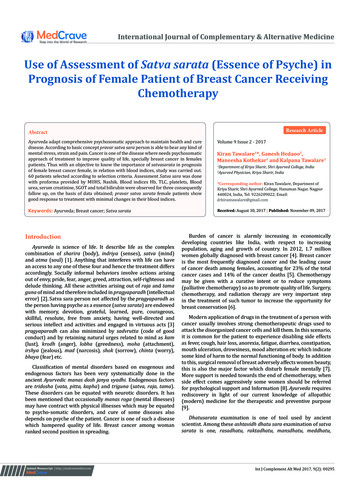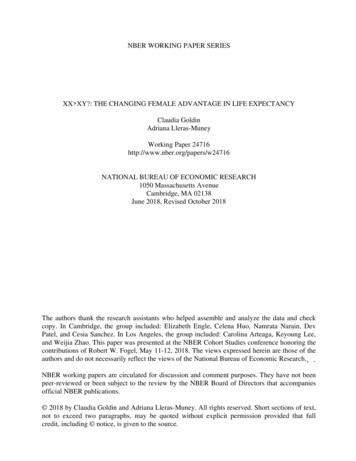
Transcription
NBER WORKING PAPER SERIESXX XY?: THE CHANGING FEMALE ADVANTAGE IN LIFE EXPECTANCYClaudia GoldinAdriana Lleras-MuneyWorking Paper 24716http://www.nber.org/papers/w24716NATIONAL BUREAU OF ECONOMIC RESEARCH1050 Massachusetts AvenueCambridge, MA 02138June 2018, Revised October 2018The authors thank the research assistants who helped assemble and analyze the data and checkcopy. In Cambridge, the group included: Elizabeth Engle, Celena Huo, Namrata Narain, DevPatel, and Cesia Sanchez. In Los Angeles, the group included: Carolina Arteaga, Keyoung Lee,and Weijia Zhao. This paper was presented at the NBER Cohort Studies conference honoring thecontributions of Robert W. Fogel, May 11-12, 2018. The views expressed herein are those of theauthors and do not necessarily reflect the views of the National Bureau of Economic Research. NBER working papers are circulated for discussion and comment purposes. They have not beenpeer-reviewed or been subject to the review by the NBER Board of Directors that accompaniesofficial NBER publications. 2018 by Claudia Goldin and Adriana Lleras-Muney. All rights reserved. Short sections of text,not to exceed two paragraphs, may be quoted without explicit permission provided that fullcredit, including notice, is given to the source.
XX XY?: The Changing Female Advantage in Life ExpectancyClaudia Goldin and Adriana Lleras-MuneyNBER Working Paper No. 24716June 2018, Revised October 2018JEL No. J1,J16,N0ABSTRACTFemales live longer than males in most parts of the world today. Among OECD nations in recentyears, the difference in life expectancy at birth is around four to six years (seven in Japan). Buthave women always lived so much longer than men? They have not. We ask when and why thefemale advantage emerged. We show that reductions in maternal mortality and fertility are not thereasons. Rather, we argue that the sharp reduction in infectious disease in the early twentiethcentury played a role. The primary reason is that those who survive most infectious diseases carrya health burden that affects organs, such as the heart, as well as impacting general well-being. Weuse new data from Massachusetts containing information on causes of death from 1887 to showthat infectious diseases disproportionately affected females between the ages of 5 and 25. Bothmales and females lived longer as the burden of infectious disease fell, but women were moregreatly impacted. Our explanation does not tell us why women live longer than men, but it doeshelp understand the timing of their relative increase.Claudia GoldinDepartment of Economics229 LittauerHarvard UniversityCambridge MA 02138and NBERcgoldin@harvard.eduAdriana Lleras-MuneyDepartment of Economics9373 Bunche HallUCLALos Angeles, CA 90095and NBERalleras@ECON.UCLA.EDU
Women live longer than men in most parts of the world today.1 In many places, theylive a lot longer. Among OECD nations in recent years, the difference in life expectancy atbirth is around four to six years (seven in Japan). But have women always lived so muchlonger than men? The answer provided in recent studies is that they have not.2Many hypotheses have been put forward to explain the so called “female advantage”in life expectancy. Most of the reasons why women live longer than men can be found byunderstanding the difference between having two X chromosomes, as opposed to having anX and a Y, and the resulting impact on hormones.3 Whereas genetic factors are at play, thefact that the advantage increased greatly in the latter half of the twentieth century, suggeststhat environmental factors, particularly those that interact with specific genetic elements,have disproportionately benefited women. In this paper, we examine when the femaleadvantage started growing, to understand what caused the advantage to widen.A complete answer concerning why there was a large increase in the femaleadvantage still eludes us. But we argue that the reduction in infectious diseases played arole in extending longevity primarily through its impact on survivors and not because ofthe reduction in deaths directly from disease. To document this we collected data fromMassachusetts containing information on causes of death from 1887 to around 1930 toshow that people dying from infectious disease between the ages of 5 and 25 wereSee, for example, Barford et al. (2006), although the data are not entirely reliable for certaindeveloping countries (and are dismal for some, particularly in Africa). On the possible reasons whywomen live longer, see Austad (2006) and Cullen et al. (2016).2 See, for example, Beltran-Sanchez et al. (2015), which uses birth cohorts for 13 nations in theHuman Mortality Database. The female longevity advantage at age 40 and beyond appearsconsistently with cohorts born in the late nineteenth century. In France, for example, in the earlynineteenth century women’s life expectancy was only about one year greater than that of men.3 Mouse experiments have allowed reseachers to separate the impacts of chromosomes fromhormones. See, for example, Arnold, et al. (2012), Chen, et al. (2012), and Du, et al., (2014).Cardiovascular disease differs between males and females for both reasons. Males have morevisceral fat whereas women have more subcutaneous fat, a difference determined by estrogen andalso by the presence of the second X chromosome in females. Visceral fat stored in the abdomenpredicts cardiovascular disease. Males, it has been shown in mouse models, are also more likely tosuffer from hypertension even in the absence of different hormones. Sex differences exist in theincidence of autism-spectrum disorders, from which males are four to ten times more likely to beaffected. Females are more likely to get auto-immune diseases, but their extra X chromosomeprotects them from more rapid degeneration once affected.1-1-
disproportionately female. As infectious disease was reduced for all, females thereforereaped more benefits than did males. Though our explanation does not tell us why womenwere disproportionately affected by infectious disesase, it helps us understand the timing of theonset of the female advantage.We should be clear at the outset regarding the impact of infectious disease and itsdecline on the female life expectancy advantage. The direct effect will be small. It is theindirect effect among the survivors that we, and others, believe greatly explains theincrease in longevity in general and the greatly widening advantage of females. Asmortality from infectious disease fell, the fraction who were the survivors and who thuscarried with them the markers of past illness, also decreased. A healthier populationresulted, and females were disproportionately impacted.Male mortality rates have always been higher for infants (Drevenstedt et al. 2008).But any advantage that females had at birth, or even those they had conditional onsurviving to year one, were slight until some time in the twentieth century.4 Gender gaps inlongevity greatly increased starting early in the twentieth century, reaching a maximum ofeight years in the US by the 1970s. The differences then narrowed, but have remainedsubstantial (Cullen et al. 2016).The reasons that women began to live much longer than men have been studied bymany. But existing explanations are incomplete. The reduction in maternal mortality aswell as the decrease in the total fertility rate, for example, have been shown to explain atmost one-seventh of the growing female advantage in longevity.5 Our estimates are withinthat range. Increased smoking by men in the early twentieth century, which greatlyUsing the metric of life expectation at one year old or, say, at 15 years of age, females lived onlyabout as long as males in many of today’s rich nations prior to 1850, and even later in some.According to the Human Mortality database, life expectancy at age one was about equal for malesand females in France in 1850 and only slightly higher for males in the UK. In Sweden, femalesappear to have lived longer than males ever since records have been kept.5 Retherford (1972), for example, showed that in the US the male-female gap at birth increased by3.43 years in favor of girls between 1900 and 1960 and that decreased maternal mortality accountsfor about half a year or 14 percent of the gap leaving a substantial unexplained portion. Ourcalculation, see Appendix Table 1, is around 15 percent.4-2-
expanded around WWII, is part of the reason that women began to live longer than men.But smoking was later taken up by women as well and that is one explanation for thenarrowing of death rate differences by sex that has occurred since the 1970s.6 Becausesmokers are affected with a 20- to 30-year delay, the full effect of the diffusion of tobaccouse will not be apparent for some time. But even with this caveat, smoking alone cannotfully account for the rise and fall in longevity gender gaps (Cullen et al. 2016; Preston andWang 2006).Our contribution is to explore the reasons behind the initial appearance and earlywidening of the female longevity advantage that started well before maternal mortalitydeclined and prior to the mortality impact of the smoking upsurge. In the US, as well as inEngland (including Wales), France, and Sweden, a noticeable female advantage amongthose aged five to twenty years old emerged at the end of the nineteenth and beginning ofthe twentieth centuries. We connect our findings on this understudied phenomenon to theexpansion of the female advantage that appeared later in the twentieth century.Young females before the turn of the twentieth century had a small but cleardisadvantage in mortality from infectious diseases. That disadvantage disappeared wheninfectious disease prevalence fell, largely due to public health interventions. We examinevarious explanations for why girls had greater infectious disease mortality rates, but findno evidence that differential mortality was due to differential nutrition by sex or neglect.We argue that, because infectious disease in early childhood can be linked to chronicdiseases in adulthood, the decline in infectious disease in the early part of the twentiethcentury generated a female advantage in childhood that later appeared as an even greaterfemale mortality advantage among adults in the second part of the twentieth century.Most of the evidence we present is for the US and comes from our analysis of thevital statistics records for Massachusetts, the first US state to collect these data. These dataBeltran-Sanchez et al. (2015) show that smoking can explain about one-third of the differencebetween male and female mortality rates at ages 50 to 70 for cohorts born in the early part of thetwentieth century. Others have found similar or larger contributions to smoking in explainingmortality gender gaps (Preston and Wang 2006).6-3-
are mainly in period, not cohort, form, but our work informs a cohort analysis. We concludethat the decrease in infectious disease as a cause of death for a cohort meant a decrease inthe later-life burden of infectious disease on other causes of death for that cohort.Our paper has four parts and proceeds as follows. In part I we review the long-runhistory of life expectancy for males and females in the US and Europe. Part II examines sexdifferences in mortality among the young and presents our findings about female excessmortality during periods of high infectious disease. Part III confronts why girls died athigher rates than did boys in the era of infectious disease. Part IV concludes with evidenceon the relationship between the early disease environment and later-life mortality.I.Life Expectancy for Males and Females: The Long RunA. The US: 1795 to 2015Life expectancy at birth (e0) increased greatly from the late nineteenth century—when it was around 50 for females—to the mid-twentieth century—when it was around 70years for females. Much of that increase was due to the reduction in infant and childmortality. These facts are well known. Of greater interest, here, is that a female advantageappeared in the US sometime in the late nineteenth century.7In each of the three life expectancy series for the US in Figure 1.1, the femaleadvantage emerges and expands after the 1890s. The widening intensified in the first thirdto first half of the twentieth century, and particularly in the post WWII period, whengrowth in male life expectancy decelerated considerably. These trends reversed course inthe 1970s when male life expectancy grew faster than that for females, and again in the1990s when female life expectancy growth decelerated. The longevity gender gap at birthreached a maximum of eight years in the early 1970s and is about five years today.The first of the Figure 1.1 graphs (part A) gives life expectancy at birth. Until the1890s life expectancy at birth was almost equal by sex. Part B, giving expectancy at age 15,shows a slight male advantage until the 1890s. The final graph (part C), giving life7We ignore, here, the far greater impact on male mortality of the American Civil War.-4-
expectancy conditional on reaching age 45, shows a female advantage throughout theperiod, albeit initially quite small. (It should be noted that in parts B and C longevity isexpressed as the expected age at death, not as years left to live.) Based on this informationit would appear that the female advantage at birth emerged in the US around 1890.The shaded portion in each of the Figure 1.1 graphs shows the period when the twoseries are connected: that from J. David Hacker (2010) for the period to 1900; and thatfrom the US Social Security Administration (SSA) for the years after. The Hacker series isalways a bit higher than SSA’s probably because the Hacker series is for whites only.Another important feature of the graphs is the sudden and short-lived disadvantage formales around 1865, due to excess male mortality from the US Civil War.Trends in the female survival advantage can be seen better in Figure 1.2, whichgives the difference (male minus female) in life expectancy for the three ages, e0, e15, ande45. Two large deviations from the story of an evolving female advantage can be seen. Oneis the US Civil War, which is responsible for the large sudden increase in male mortalityaround 1865.8 The other is the relative decrease in male longevity in the 1910s due toWorld War I. The opposite impact around 1920 is due to the 1918 influenza pandemic.Although we will show that the flu pandemic of 1918 produced a mortality disparity thatrelatively disadvantaged females, male war casualties overwhelmed it early on.The conclusions from Figures 1.1 and 1.2 are that the female advantage conditionalon surviving to age 15 appeared around the turn of the twentieth century. That at birth andconditional on surviving to age 45 were present to some degree before. That said, theadvantage widened considerably in all three cases after 1930 and then narrowed after1970.Males who survived to age 15 did better than females who survived to age 15 untilthe late nineteenth century. But females who survived to age 45 did a bit better than maleswho survived to age 45 throughout the nineteenth century. The mortality consequences of-5-
childbirth, either due to maternal mortality or the subsequent mortality consequences ofmaternal morbidity, may have caused the small differences between e15 and e45. But we willshow that there are other reasons why women began to live a lot longer than men startingin the late nineteenth century. We also show that maternal mortality declines explain onlya small faction of the emerging female longevity advanage.B. Europe: Early-Nineteenth Century to 2000sWe provide similar life expectancy data and differences by sex at various ages forEngland (including Wales), France, and Sweden. These countries share some, but not all, ofthe features just described for the US. When measured by life expectancy at birth, femalesin these nations had an advantage earlier than in the US. Recall that in the US, the femaleadvantage emerged in the 1890s.For the European data we use the Human Mortality Database (HMD) and presentthe data in Figure 1.3 as the difference between male and female life expectancy at birthand conditional on surviving to ages 15 and 45 (e0, e15 and e45), as we did in Figure 1.2 forthe US.9 Females in England (part A) and France (part B) had a significant edge on malesfrom birth from the mid- to late-nineteenth century and the advantage then greatlyexpanded as it did in the US.10 Sweden (part C) is different. A female mortality advantage isapparent at all ages and as far back as the data will allow us to go.11 But these differencesshrink up to 1930. In all the countries considered, including the US, the female advantagegreatly expanded after WWII and then started to shrink after the 1970s.England and Wales, France, and Sweden are the most populous European nations with highquality vital statistics data from at least 1850. There are several other countries with earlynineteeth century data in the HMD back to 1850, including Belgium, Denmark, Iceland, theNetherlands and Norway. But these countries are not as populous and, in consequence, the data arenoisy. The HMD data are available online at http://www.mortality.org/. We will refer to Englandand Wales as England going forward.10 Cullen et al. (2016) report that male life expectancy exceeded female life expectancy at birth in1900 in England and France also using the Human Mortality Database. The database has beenupdated and extended, and the data revisions account for the differences between our figures andtheirs (personal communication).11 We only plot years with population censuses.9-6-
The reason for “Swedish exceptionalism” is not entirely clear but may stem from thelow prevalence of infectious disease in nineteenth century Sweden. Swedish infantmortality rates were also low through the nineteenth century. They started their declinearound 1810, far earlier than in England and France (Lynch and Greenhouse 1994).Because infant mortality rates were largely due to infectious diseases, these patternssuggest that the female advantage emerged earlier in Sweden because the infectiousdisease environment was lower.12 But no data on mortality by cause of death exist toconfirm the hypothesis.Our discussion of the European mortality data has ignored the role of war largelybecause our figures include only years when census data was collected (and thus when wehave accurate population counts), and censuses are generally not taken during conflict. Butlarge prolonged wars sharply increase death rates among young adults, significantly moreso for men than women. Male deaths skyrocketed beginning in 1914 and returned to theirprevious levels only after 1919. In England, among 20 to 30 year olds, ten times more menthan women died during 1914-1919. (Fifteen times more men than women in France inthe same period).13 Although women also died more during the war than at other times, theincrease in their deaths was largely confined to the flu pandemic years.II.Sex Differences in Mortality among Children and Young AdultsA. Relative Deaths by Sex: MassachusettsHistorical evidence on deaths by age and cause of death for the state ofMassachusetts (MA) allow us to better understand aggregate US trends. MA has the longestand highest quality vital statistics data among all US states.14 Death counts broken down bysex, age-group, and cause are available annually starting in 1885. Identical data for theentire US population are available only from 1933, well after the female advantageAn added question is why gaps in life expectancy shrank in Sweden before 1930 when they wereexpanding elsewhere. Cullen et al. (2016) suggest that gender gaps evolve with demographic andepidemiological transitions, and Sweden appears to have transitioned earliest.13 Results not shown but available upon request.14 Massachusetts, in 1842, was the first state to pass a state registration law.12-7-
appeared.Figure 2.1, parts A to D give the mortality series for males and females from 1887 to1940 for four age groups: 5 10, 10 15, 15 20, and 20 30 years.15 Because of the relativelysmall number of annual deaths in some of these age brackets, the data are expressed as athree-year centered moving average. We exclude 1918 from the three-year average, due tothe large number of deaths from the pandemic, and include those deaths separately for thatyear.There are three lines in each graph. Two give the number of male and female deathsin each year for the relevant age group. The dashed line gives the ratio (Males/Females) ofthe two series and is mapped on to the right axis. Equality of the ratio is given by a thickerline and an arrow.Male deaths exceeded female deaths to around 1900 for all four age groups.16 Alsoimportant is the sharp decrease in the male to female death ratio in 1918 for 10 15 yearolds as well as a smaller decrease for the 5 10 year olds. Females between 10 and 15 yearsold were dying at higher rates than males in 1918. It is possible that these differencesextend to the 15 20 year group, but deaths of young men in World War I are a confoundingfactor and could mask the effect of the flu. Interestingly, the gender death ratio was lessthan one for 20 30 year olds from 1918 to 1935.17The main conclusion is that female children, especially those between 10 and 15years old, died at higher rates in 1918 from the flu than did males. Relative deaths after theflu pandemic resumed the previous trend of an increasing number of male than femaledeaths, thus widening the female advantage.The fact that more females 10 15 died from the virulent flu of 1918, suggests thatWe begin the series with 1887 because the probable cause of death was aggregated in somemeaningful manner beginning in that year.16 These are the absolute number of deaths in all of Massachusetts, by gender, in each year.17 Noymer and Garenne (2000) attribute the temporary decline in the female advantage amongadults to the delayed effects of the influenza pandemic. The pandemic, according to them, may havekilled weaker males thus lowering mortality rates in subsequent years among male survivors.15-8-
young females may have also died at higher rates from other infectious diseases, at leastafter age one.18 That is what we found. Public health interventions that reduced the burdenof infectious disease, therefore, disproportionately decreased female (non-infant) deathsand increased female life expectancy relative to male.19Of equal interest is that the 20 30 year old group in MA shows a distinct breakaround 1920. Previously, women had died at lower rates than men in that age group. Butafter 1920 both men and women in that age group died at significantly lower rates thanbefore. The reason for the decrease for both sexes, we will soon demonstrate, is that deathsfrom infectious diseases of all types, but particularly from water-borne diseases, decreasedsubstantially around 1900. Deaths in childbirth, however, had not yet decreased andtherefore the remaining deaths in the 20 30 year old group tilted relatively towardwomen.B. Relative Deaths by Sex: England and FranceThe female advantage among youth 10 15 appears later in England and France thanin MA. Recall that life expectancy at various ages demonstrated an earlier female advantagethan in the US. But as can be seen in Figure 2.2, deaths among male youths 10 15 inEngland systematically started to exceed deaths of female youths 10 15 only sometimearound 1925, and they never exceeded female deaths in France.Young women (under 25 years) succumbed to pulmonary tuberculosis at higher rates than didyoung men (Hacker 2010; Henry 1989; Madigan 1957). The opposite is true among adults olderthan 25 years—males appear to have been more susceptible to TB in the early twentieth century(Noymer and Garenne 2000, figure 7). Note that the greater infant mortality rate for males thanfemales is attributed to a greater susceptibility to infectious diseases among male infants (see, e.g.,Drevenstadt et al. 2008). But after around age five, females appear to be more susceptible toinfectious diseases.19 On public health measures that began in the late nineteenth century and gained greaterimportance in the early twentieth century, see Cutler and Miller (2005) on the role of filtration andchlorination of water, and Alsan and Goldin (2018) on water and sewerage systems. Omran (2005)discusses the notion that the overall epidemiologic transition from infectious to chronic diseasefavored women. Beltran-Sanchez et al. (2015) note that females may have some inherentvulnerability to infectious disease relative to males after infancy, but that they have various geneticprotections against chronic diseases, except those in the autoimmune category.18-9-
Figure 2.2 has been drawn in a manner similar to that of Figure 2.1 for MA.20 In aparallel manner to the MA case, girls suffered greater losses than boys during the flupandemic years in England and France, resulting in a sharp decline in the ratio of male tofemale deaths. As in the MA case, by looking at the evolution of mortality by sex for 10 15year olds, we can remove some of the direct effect of the war because males would havebeen too young to serve. Since the pattern is similar to that for MA, it is probably due to agreater susceptibility of young females to the flu, though we cannot fully separate the effectof the war in Europe from that of the flu.C. Death Rates by Sex: MA and EuropeThe main finding from Figure 2.1 is that deaths of young males and females in theUS became equal around 1895 for the age groups given. These data are suggestive of anemerging female advantage. But the evidence is not definitive because the data have notbeen expressed as a fraction of the population. In fact, the population of males and femalesby age deviated from equality in MA in the 1920s. Textile production in the US shifted fromthe northeast to the south and the manufacturing economy of the Commonwealth took adive. In consequence, young men left the state in greater numbers than did women.21 Wenow present data for census years that divides by population and expresses these numbersas rates for census years, not as raw numbers as we did before.We use population data at census intervals to create death rates for the four agegroups 5 10, 10 15, 15 20, and 20 30 years.22 In between census years accuratepopulation estimates can only be computed with information on migration, which does notTo mirror what we do for MA, we construct three-year moving averages, except for the war years,which are not part of any average. Sweden is omitted because of its much smaller population.21 The ratio of males to females in the 20 30 year group declined in the 1910s and 1920s and thenrecovered in the 1930s. Source: US Census of Population, Massachusetts.20Age Group15 2020 2525 9019401.000.950.94Death rates are estimated at decade intervals because of the need for accurate population data.-10-
exist at high enough frequency by age and sex.Figure 2.3 provides the rates for males relative to females. The relative rates showthat the female advantage did not exist in 1890 for any of the four age groups, but that itdid exist for three of them by 1900 and for all by 1910. In the case of the three youngergroups shown, the trajectory from 1890 to 1940 shows that the relative gains made byfemales continued to 1940 at least.For the two age groups 15 20 and 20 30, the flu pandemic and WWI break thetrend. Furthermore, by 1930 the burden of infectious disease had become sufficiently low,as noted before, that only persistent maternal mortality prevented the female death ratefrom continuing its relative descent. But after 1937, with the introduction of sulfa drugsand soon after with the innovation and diffusion of antibiotics, the female death rate in theprime reproductive ages became substantially less than that for men.23Figure 2.4 (drawn to the same scale as Figure 2.3) shows similar mortality rate datafor England from roughly 1880 to 1930. The female advantage for these four ages groupsalso appears sometime around the turn of the century (except for the 10 15 group). Butthe advantage in MA, when it appeared, was considerably greater for all ages. By 1930 and1940, the ratio of male to female mortality below age 20 in MA was about 1.2 or higher, butthe ratio never exceeded 1.2 in England.D. Cause of Death by SexThe female longevity advantage, as we have shown, appeared in the US and in MAaround the 1890s. We now demonstrate that infectious disease as a cause of death declinedsignificantly after 1890, as public health measures, such as clean water and seweragesystems, spread across municipalities and states (Alsan and Goldin 2018).Various problems arise in categorizing cause of death in the past. The mostOn the role of sulfa drugs in reducing maternal deaths in the US, see Jayachandran, Lleras-Muney,and Smith (2010).23-11-
important is that cause of death was not always known (occasionally not even today) anddiseases can be manifested in a variety of ways. As knowledge advanced, cause of deathcategories became more accurate. In the MA data, cause of death categories increased fromsix major groups starting in 1850, to 14 in 1901, 15 in 1921 and 18 in 1931.A far greater fraction of deaths of females than of males in the 10 15 year groupwere due to infectious disease throughout the period, as can be seen in Figure 2.5, part A.But more males than females died from external and violent causes. Therefore, we mustalso show that deaths from infectious disease were greater for females than males even ifwe exclude the violent and external death category. Except for the years after 1925 and forthose with significant infectious disease epidemics, the fraction of non-violent deaths frominfectious disease was higher for females than for males, as can be seen in Figure 2.5, partB.
women live longer, see Austad (2006) and Cullen et al. (2016). 2 See, for example, Beltran-Sanchez et al. (2015), which uses birth cohorts for 13 nations in the Human Mortality Database. The female longevity advantage at age 40 and beyond appears consistently with cohorts born in the late
